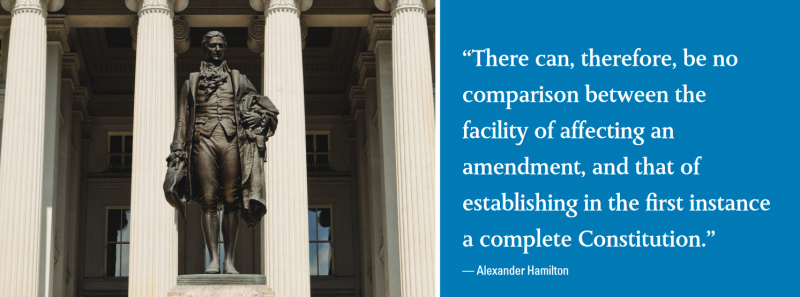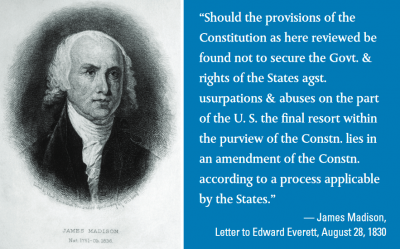Article 14 - An Article V Convention is not a Constitutional Convention
An Article V Convention Is Not a Constitutional Convention
By Ken Quinn
A common misconception about an Article V convention is that it is identical to a Constitutional Convention. Unfortunately, today some people believe this, due to false information propagated by groups opposed to the states exercising their constitutional authority. A cursory review of the writings of the Framers during the creation and ratification of the Constitution clearly demonstrates, however, that an Article V convention is not the same as a Constitutional Convention (or a “Con-Con,” as opponents like to call it). Here is what history tells us.
The Framers Rejected a Proposal to Give Article V Conventions More Power
On September 15, 1787, the delegates at the Constitutional Convention unanimously approved adding the convention mode to Article V in order to give the states authority to propose constitutional amendments without the consent of Congress. Immediately after that vote, a motion was made by Roger Sherman to remove the three-fourths requirement for ratification of amendments. This would have given future conventions even more authority by allowing them to determine how many states would be required to ratify their proposals.
James Madison described the motion: “Mr.Sherman moved to strike out of art. V. after “legislatures” the words “of three fourths” and so after the word “Conventions” leaving future Conventions to act in this matter, like the present Conventions according to circumstances.” This motion was rejected by the Framers, clearly indicating their in-tent to limit the power of future Article V conventions within carefully delineated constitutional boundaries.
James Madison himself makes it clear that a Constitutional Convention and an Article V convention are separate and distinct entities. According to Madison:
“A Convention cannot be called without the unanimous consent of the parties who are to be bound by it, if first principles are to be recurred to; or without the previous application of 2⁄3 of the State legislatures, if the forms of the Constitution are to be pursued.”
Notice how he described that a Constitutional Convention (first principles) requires unanimous consent to be called by the parties that are to be bound to it, whereas an Article V convention (forms of the Constitution) only requires application by 2⁄3 of the states.
This high bar of unanimous consent “of the parties who are to be bound to it” is required for a convention to propose a new Constitution, but not for an amendment-proposing convention, which only requires 2⁄3 of the states to call. Also, a state is only bound by a new Constitution if it ratifies it; this is not the case for an individual amendment. Once three-fourths (38) of the states ratify an amendment, all 50 states are bound by it.
A New Constitution Must Be Ratified As a Whole Document, Whereas Amendments Are Ratified Individually
Another major difference between a Constitutional Convention and an Article V convention for proposing amendments is the passage and ratification process. A new Constitution must be passed and ratified as a complete document, whereas amendments are passed and ratified individually. Alexander Hamilton explains in Federalist 85:
“Every Constitution for the United States must inevitably consist of a great variety of particulars…. Hence the necessity of moulding and arranging all the particulars which are to compose the whole, in such a manner as to satisfy all the parties to the compact; and hence, also, an immense multiplication of difficulties and casualties in obtaining the collective assent to a final act…. “But every amendment to the Constitution, if once established, would be a single proposition, and might be brought forward singly…. The will of the requisite number would at once bring the matter to a decisive issue. And consequently, whenever nine ( 2⁄3), or rather ten States ( 3⁄4), were united in the desire of a particular amendment, that amendment must infallibly prevail. There can, therefore, be no comparison between the facility of affecting an amendment, and that of establishing in the first instance a complete Constitution.”
| DIFFERENCES BETWEEN A CONSTITUTIONAL CONVENTION AND AN ARTICLE V CONVENTION | ||
|---|---|---|
| ACTION | CONSTITUTIONAL CONVENTION | ARTICLE V CONVENTION |
| Propose | Propose New Constitution | Propose Amendments to Current Constitution |
| Power | Full Powers, Unlimited | Limited to Subject of State Applications |
| Authority | Outside of the Constitution | Under Article V of the Constitution |
| Requirement to Call | Unanimous Consent of States to be Bound | Application by Two-thirds of the States |
| Called By | The States | Congress |
| Scope of Passage at Convention | Entire Constitution as a Whole Document | Individual Amendments, Singly |
| Votes for Passage at Convention | Unanimous Consent Required | Simple Majority |
| Scope of Ratification by the States | Entire Constitution as a Whole Document | Individual Amendments, Singly |
| Votes for Ratification by the States | Only Binds States That Ratify It | Ratified by Three-fourths and Binds All States |
Text of Article V Unequivocally States “Convention for Proposing Amendments” Article V could not be any clearer in regards to the powers a convention is given. Here is the relevant portion of text: “The Congress, whenever two thirds of both Houses shall deem it necessary, shall propose Amendments to this Constitution, or, on the Application of the Legislatures of two thirds of the several States, shall call a Convention for pro-posing Amendments….” It is absolutely disingenuous to claim that an Article V convention can propose an entirely new Constitution. The words “for proposing amendments” could not be any clearer. Article V gives a convention the exact same authority as Congress: the power to propose amendments — nothing more, nothing less.
Text of Article V Does Not Allow For a New Constitution to Be Drafted
Last but not least is the fact that Article V does not allow for a new Constitution to be drafted, because the text states: “Congress … shall call aConvention for proposing Amendments, which, in either Case, shall be valid to all Intents and Purposes, as Part of this Constitution, when ratified by the Legislatures of three fourths of the several States, or by Conventions in three fourths thereof….” When ratified, the amendments proposed by a convention become part of our current Constitution. A convention can-not, under the plain text of Article V, set up a new constitution.



